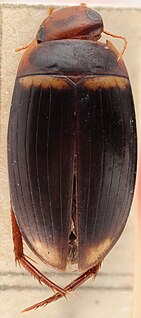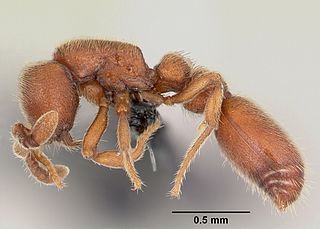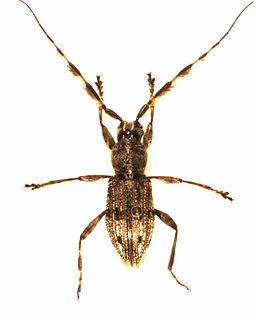
Thelytoky is a type of parthenogenesis in which females are produced from unfertilized eggs, as for example in aphids. Thelytokous parthenogenesis is rare among animals and reported in about 1,500 species, about 1 in 1000 of described animal species, according to a 1984 study. It is more common in invertebrates, like arthropods, but it can occur in vertebrates, including salamanders, fish, and reptiles such as some whiptail lizards.

Cophixalus biroi is a species of frog in the family Microhylidae found in New Guinea. Its natural habitats are subtropical or tropical moist lowland forests and subtropical or tropical moist montane forests.
Oreophryne biroi is a species of frog in the family Microhylidae. It is endemic to New Guinea and occurs on the north coast from Madang Province in Papua New Guinea to the Cyclops Mountains in Papua province, Western New Guinea (Indonesia). The specific name biroi honours Lajos Bíró, a Hungarian zoologist and ethnographer who collected the holotype. Common name New Guinea cross frog has been coined for it.

Amantis is a genus of praying mantids native to Asia and the islands of the Pacific Ocean and now belongs to the monotypic tribe Amantini of the subfamily Iridopteryginae.
Amantis biroi is a species of praying mantis native to India, the Maluku Islands, Sulawesi, and the Sunda Islands.
Mordellistena biroi is a species of beetle in the genus Mordellistena of the family Mordellidae. It was described in 1977 by Ermisch and is endemic to Hungary.

Copelatus biroi is a species of diving beetle. It is part of the genus Copelatus in the subfamily Copelatinae of the family Dytiscidae. It was described by Guignot in 1956.

Ooceraea biroi, the clonal raider ant, is a queenless clonal ant in the genus Ooceraea. Native to the Asian mainland, this species has become invasive on tropical and subtropical islands throughout the world. Unlike most ants, which have reproductive queens and mostly nonreproductive workers, all individuals in a O. biroi colony reproduce clonally via thelytokous parthenogenesis. Like most dorylines, O. biroi are obligate myrmecophages and raid nests of other ant species to feed on the brood.

Parmenini is a tribe of longhorn beetles of the subfamily Lamiinae.
Sphecodes biroi is a species of bee in the genus Sphecodes, of the family Halictidae.
Aenictus biroi is a species of reddish brown army ant found in Sri Lanka.
Ropica biroi is a species of beetle in the family Cerambycidae. It was described by Breuning in 1953.
Trichohestima biroi is a species of beetle in the family Cerambycidae. It was described by Breuning in 1953.
Carpathonesticus is a genus of spiders in the family Nesticidae. It was first described in 1980 by Lehtinen & Saaristo. As of December 2019, it contains 21 species.
Cobria biroi is a species of beetle in the family Cerambycidae. It was described by Stephan von Breuning in 1953. It is known from Papua New Guinea.
Carpathonesticus biroi is a species of araneomorph spider of the family Nesticidae. It occurs in Romania, where it is found in caves.
Carabus biroi is a species of ground beetle in the large genus Carabus that is endemic in Turkey.
Schizoglyphus is a monotypic genus of mites belonging to the monotypic family Schizoglyphidae. The only species is Schizoglyphus biroi.
Arbanitis crispus is a species of armoured trap-door spider in the family Idiopidae, and is endemic to New South Wales.





